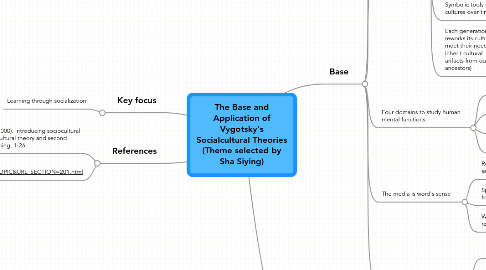
1. Key focus
1.1. Learning through socialization
2. References
2.1. Lantolf, J. P. (2000). Introducing sociocultural theory. Sociocultural theory and second language learning, 1-26.
2.2. UNESCO (n.d.). Vygotsky’s Sociocultural Theory. UNESCO Webiste. http://portal.unesco.org/education/en/ev.php-URL_ID=26925&URL_DO=DO_TOPIC&URL_SECTION=201.html
3. Base
3.1. The task of psychology is to understand how human activity is organized through culturally constucted artifacts
3.2. Human mind is mediated.
3.2.1. Human do not act directly on the physical world. (indirectly connected to the world)
3.2.2. We act on tools and labours
3.2.3. We also use symbolic tools or signs
3.2.3.1. Numbers
3.2.3.2. Music
3.2.3.3. Art
3.2.3.4. Languages
3.2.3.5. etc.
3.2.4. Symbolic tools or signs are created by human cultures over time
3.2.5. Each generation reworks its cultural to meet their needs (we inherit cultural arifacts from our ancestors)
3.3. Four domains to study human mental functions
3.3.1. phylogenetic
3.3.2. sociocultural
3.3.3. ontogenetic (main)
3.3.4. microgentic
3.4. The media is word's sense
3.4.1. Rejects thinking and speaking are the same thing
3.4.2. Speaking serves as a means of transmitting formed thoughts
3.4.3. Word's sense is in the center of researching mind development.
3.5. Vygotsky's research findings
3.5.1. Assistance is useless in the development of children's mind.
3.5.2. External meditation is internalized.
3.5.3. Child’s cultural development appears twice (From interpsychological to intrapsychological)
3.5.3.1. First between people
3.5.3.2. Then inside the child.
4. Application
4.1. In school, traditional transmissionist or instrucationist changed
4.2. Promotes learning contexts in which students play an active role in learning. Learners should be provided with socially rich environments
4.3. Roles of the teacher and student are shifted
4.3.1. Teacher: facilitator & collaborator---facilitate meaning construction in students
4.3.2. Students: construct meaning
4.3.3. Reciprocal experience
